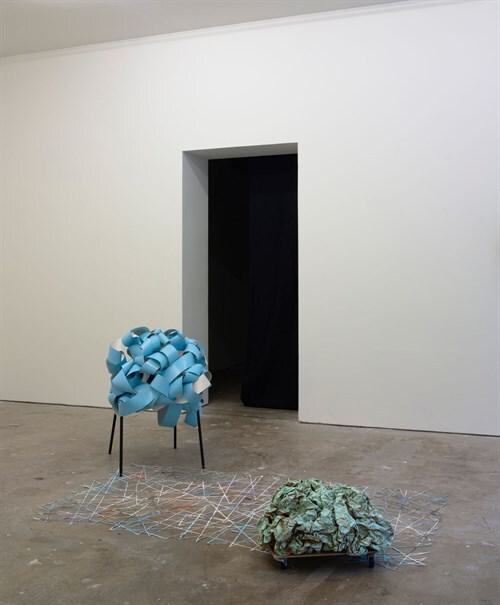Rachel Adams selected by Stacy Brodrick (2010)

Rachel Adams, Thin White Duke, 2009. Shredded paper, emulsion, found furniture. 160 x 80 x 80 cm. Credit: H Kosaniuk
Stacy Boldrick of the Fruitmarket Gallery, Edinburgh profiles the work of sculptor Rachel Adams
Rachel Adams makes sculpture that is concerned with the liberation of materials from the constraints of their conventional properties. Most of her work is made out of paper – photocopier paper, wall liner paper, paper plates.
One of the most fundamental characteristics of any piece of paper is its flat, double-sided surface, a surface disrupted by Adams’s acts of shredding, folding, scrunching or crumpling. Paper is also thin and light, and perhaps relatively a-historical, but in its transformation into sculpture, Adams gives it mass and a concentrated presence, an almost animal-like vitality and a history. 'Crumple' (2010) is ready to whiz away on casters; 'Landed' (2010) has indeed landed, but is positioned to take flight again at any moment.
Anthropomorphism aside, Adams’ attitude to materials is direct and visceral: labour and craft are critical to her practice. She prefers to make things herself, occasionally integrating into sculptures found objects such as curtain rings and tent poles. Adams uses readily available, inexpensive materials and equipment, including photocopier paper, paint and office shredders. Coloured photocopier paper has a particular sheen, palette and weight; Adams often applies gouache to flatten out the material, later shredding or folding it. Larger work is made out of brown paper that is also often painted.

Rachel Adams, Golden Years, 2009. Dimensions variable. Mixed media. Credit: H Kosaniuk
Although abstract, Adams’ work is at home in a domestic environment: it is similar in scale and sometimes in form to furniture, although it does not function like furniture. In fact, the work fails to ‘function’ at all. Its dissimilarity to functional objects, and its complete lack or denial of functional potential, rather than its dysfunction (its potential to function that ends in failure), distinguishes the work and makes it compelling. Its visual associations are multifarious and open-ended: sculptures can look like pairs of vintage clocks or sets of eyelashes, as in 'Golden Years' (2009). In 'Polar' (2009), a composition of tent poles, curtain rings and pink ribbon do not allude to a familiar object, yet the individual elements convey a range of affinities and possibilities.
Adams confounds the desire to locate the work’s primary meanings in some sort of functional capacity. One of the founding philosophers of phenomenology, Henri Bergson wrote about the experience of any object in terms of its relationship to function: ‘To recognize a common object is mainly to know how to use it. This is so true that early observers gave the name apraxia to that failure of recognition which we call psychic blindness’ (Matter and Memory 1908 edition, trans. N.M. Paul and W.S. Palmer, New York, Zone Books, 1996: 93). Adams’ work presents an amalgamation of resemblances resulting in a response akin to psychic blindness – an inability to identify the object in relation to function – which grants the work its own beauty and authority.
Stacy Boldrick, May 2010
About Rachel Adams
Rachel Adams is based in Edinburgh. She studied Fine Art at the University of Edinburgh and Edinburgh College of Art. In 2009 Adams was awarded a Visual Art Creative and Professional Development Grant from the Scottish Arts Council and a Visual Arts and Crafts Award from Edinburgh City Council.
Exhibitions include Ekkert Nytt Undir Sólinni/Nothing New Under the Sun, Skaftfell Centre for Visual Art, Seyðisfjörður, Iceland; Salon, Embassy Gallery, Edinburgh; Blind Alchemy, Royal Standard, Liverpool and Studio Warehouse, Glasgow (all 2010), New Work Scotland Programme (solo exhibition), Collective Gallery, Edinburgh (2009/10); ‘_’, Satellite, Newcastle; Time is a Sausage, Domobaal, London; 4 New Sensations, A Foundation, London (all 2009); Catalyst Art Annual Student Show, Catalyst Arts, Belfast (2008).
About Stacy Boldrick
Stacy Boldrick is Research and Interpretation Manager at The Fruitmarket Gallery, where she is responsible for programming talks and seminars and for writing and producing interpretative materials for exhibitions.
After completing an MA at the University of Pittsburgh and a PhD in History of Art at the University of Manchester, Stacy was Research Co-ordinator for the Henry Moore Institute in Leeds, where she curated Homes for the Soul: Micro-architecture in Medieval and Contemporary Art and, with David Park and Paul Williamson, she curated Wonder: Painted Sculpture from Medieval England. From 2002 to 2007, Stacy co-ordinated research projects between institutional partners in VARIE (Visual Arts Research Institute Edinburgh) and was an occasional lecturer at the University of Edinburgh. With Richard Clay she edited Iconoclasm: Contested Objects, Contested Terms (Ashgate, 2007). Stacy is an Honorary Fellow in History of Art at the University of Edinburgh, and writes about medieval and contemporary art.
These biographies were written in (2010) as part of the Open Frequency programme. For the most current information, please visit:
Open Frequency (2004–2014)
This profile was part of Open Frequency, an Axis programme that highlighted emerging developments in contemporary art practice across the UK. Artists were selected and profiled by leading curators, artists, and writers, offering unique insights into the practices shaping contemporary art at the time. These archives remain a valuable resource for understanding the trajectory of some of the most exciting artists of the period.
Helping Artists Keep Going
Axis is an artist-led charity supporting contemporary visual artists with resources, connection, and visibility.


